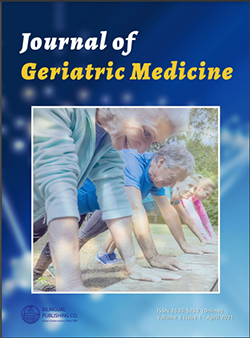 Correction & Withdrawal Policies
Correction & Withdrawal Policies
Alzheimer’s Disease among American Minority Populations: An Ecological Exploratory Study
DOI:
https://doi.org/10.30564/jgm.v3i1.2907Abstract
A significant public health concern with regards to increasing rates of Alzheimer’s is that it disproportionately affects minority groups in the United States. The present ecological exploratory study uses secondary aggregate data from the fifty United States in the year of 2019. The purpose of this study was to address the disparities in Alzheimer’s in minority populations in the US and explore associated factors. The “minority” populations considered were African American and Hispanic populations, and the “majority” population was referred to as “white”. The data were extracted from the United States Census Bureau, the CDC National Center for Health Statistics, and the Behavioral Risk Factor Surveillance System (BRFSS) Dataset. The prevalence rates of Alzheimer’s disease are greatest in both older Hispanic (12.2%) and African Americans (13.8%), compared to older whites (10.3%) in the investigated time period. Our results showed that being over 65 years old (p=.009), with a below-average ($62,843) median household income (p=.024), history of stroke (p=.029), and being a part of the Hispanic population (p=.036), were significantly associated with Alzheimer’s mortality rates in the United States. By identifying disparities in access to Alzheimer’s healthcare and at-risk communities, more comprehensive intervention strategies can be developed to promote change and advocate for more Alzheimer’s education and resource allocation for minority populations.
Keywords:
Alzheimer’s disease, Dementia, Minority populations, Mortality, Stroke, Over-65References
[1] The National Institute on Aging (NIA). (2017, May 16). What Is Alzheimer's Disease? https://www.nia.nih.gov/health/what-alzheimers-disease
[2] Healthy People 2020. (2020, October 8). Dementias, Including Alzheimer's Disease. https://www.healthypeople.gov/2020/topics-objectives/topic/dementias-including-alzheimers-disease
[3] Alzheimer's Association. (2020, June 1). Causes and Risk Factors for Alzheimer's Disease. https://www.alz.org/alzheimers-dementia/what-is-alzheimers/causes-and-risk-factors
[4] 2018 Alzheimer’s disease facts and figures. (2018). Alzheimer’s & Dementia, 14(3), 367-429. DOI:https://doi.org/10.1016/j.jalz.2018.02.001
[5] Rizzi, L., Rosset, I., & Roriz-Cruz, M. (2014). Global epidemiology of dementia: Alzheimer's and vascular types. BioMed research international, 2014, 908915. DOI:https://doi.org/10.1155/2014/908915
[6] Epidemiology of Alzheimer’s disease: occurrence, determinants, and strategies toward intervention. (2009). Alzheimer’s Disease and Mild Cognitive Impairment, 11(2), 111-128. DOI:https://doi.org/10.31887/dcns.2009.11.2/cqiu
[7] Alzheimer’s Association. (2020). 2020 Alzheimer's disease facts and figures. Alzheimer's & Dementia: The Journal of the Alzheimer's Association, 16(3), 391-460. DOI:https://doi.org/10.1002/alz.12068
[8] 2019 Alzheimer's Disease Facts and Figures Report. (n.d.). Retrieved October 18, 2020, from https://www.alz.org/media/Documents/alzheimersfacts-and-figures-2019-r.pdf
[9] Minority Health. (2018). Retrieved February 01, 2021, from https://www.niaid.nih.gov/research/minority-health
[10] Stats of the States - Alzheimer’s Disease Mortality. (2020). CDC. https://www.cdc.gov/nchs/pressroom/sosmap/alzheimers_mortality/alzheimers_disease.ht
[11] Increased Risk for Obesity and Diabetes with Neurodegeneration in Developing Countries. Top 10 Contribution on Genetics. Chapter 1, EBook. 2018. https://www.avid.science.com
[12] Cristina Aguayo-Mazzucato, Paula Diaque, Sonia Hernandez, Silvia Rosas, Aleksandar Kostic, and Augusto Enrique Caballero. Understanding the growing epidemic of type 2 diabetes in the Hispanic population living in the United States. Diabetes Metab Res Rev. 2019 Feb; 35(2): e3097.
[13] Single Gene Inactivation with Implications to Diabetes and Multiple Organ Dysfunction Syndrome. J Clin Epigenet. 2017; Vol. 3 No. 3:24.
[14] Anti-Aging Genes Improve Appetite Regulation and Reverse Cell Senescence and Apoptosis in Global Populations. Advances in Aging Research, 2016, 5, 9-26.
[15] Nutrition Therapy Regulates Caffeine Metabolism with Relevance to NAFLD and Induction of Type 3 Diabetes. J Diabetes Metab Disord. 2017; 4: 019.
Downloads
How to Cite
Issue
Article Type
License
Copyright © 2021 Maria LaQuaglia, Santiago Yacovino, Marina Celly Martins Ribeiro de Souza, Carolina Marques Borges

This is an open access article under the Creative Commons Attribution-NonCommercial 4.0 International (CC BY-NC 4.0) License.




 Maria Laquaglia
Maria Laquaglia





